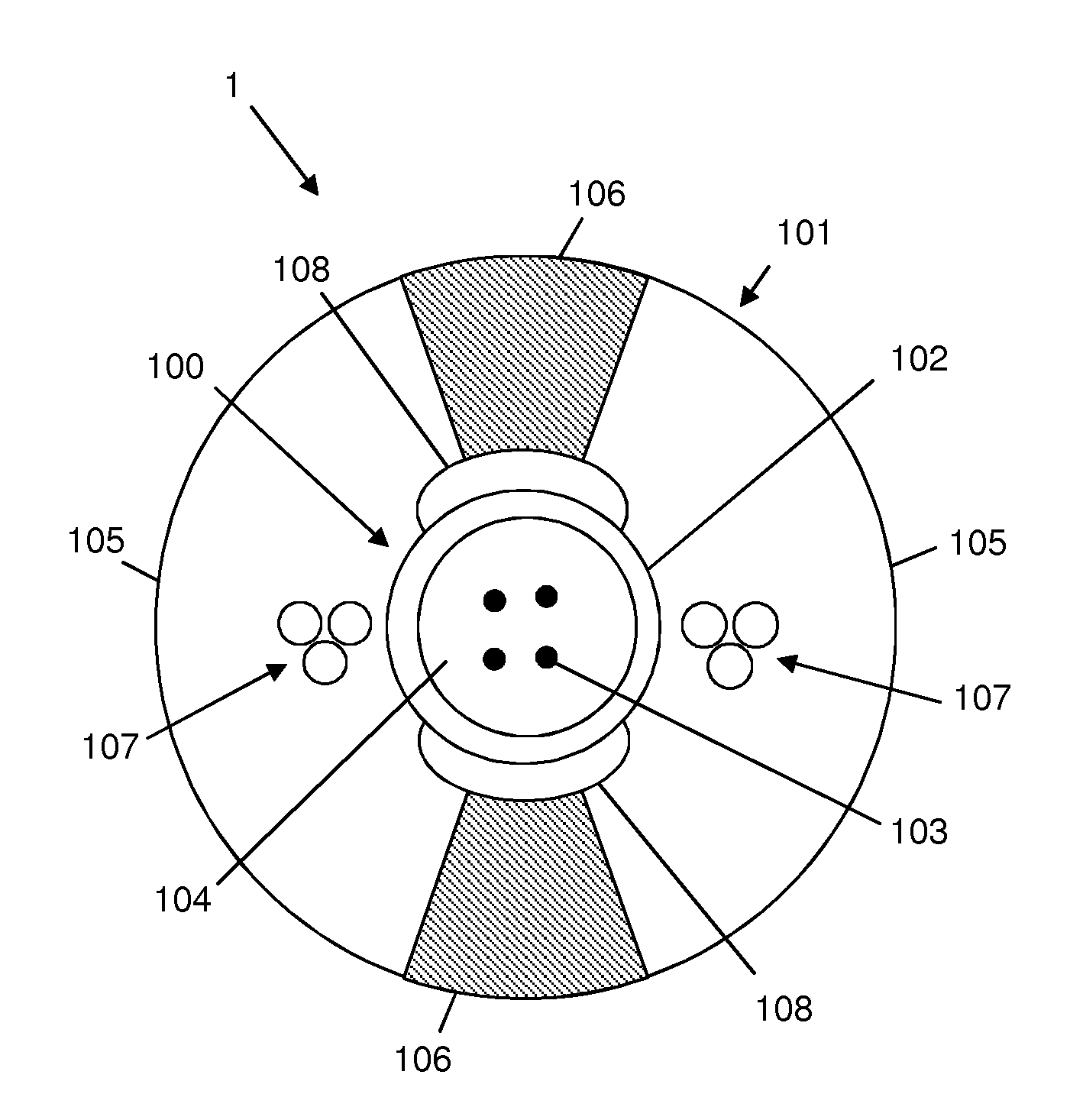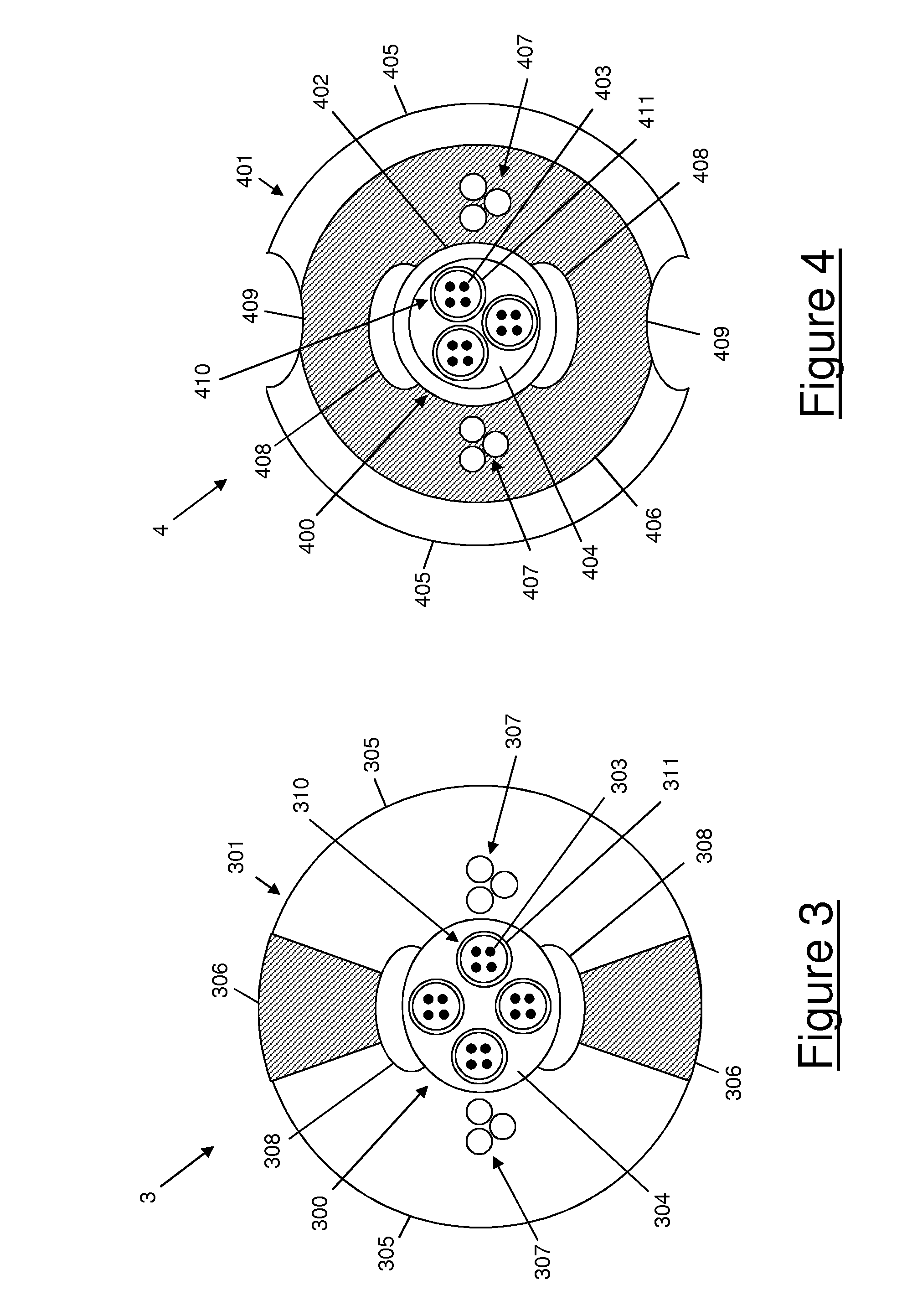Optical cable for terrestrial networks
a technology of optical cables and terrestrial networks, applied in the field of optical cables, can solve the problems of reducing the mechanical stability of the sheath, increasing the thickness of the jacket, and so as to achieve the effect of preserving the integrity of the jacket, reducing the risk of injuries, and easy removal
- Summary
- Abstract
- Description
- Claims
- Application Information
AI Technical Summary
Benefits of technology
Problems solved by technology
Method used
Image
Examples
second embodiment
[0074]FIG. 2 shows an optical cable 2 according to the present invention.
[0075]The optical cable 2 according to the second embodiment of the present invention is a drop cable for FTTH or FTTP applications.
[0076]The optical cable 2 comprises an optical core 200 and a sheath 201 surrounding the optical core 200.
[0077]The optical core 200 comprises a buffer tube 202 and a number of optical fibers 203. The features of the optical core 200 and its components are similar to that of the optical core 100 shown in FIG. 1. Therefore, a detailed description will not be repeated.
[0078]According to the second embodiment, the sheath 201 comprises a first longitudinally extending portion 205 made of a first, higher fracture toughness material and a second longitudinally extending portion 206 made of a second, lower fracture toughness material.
[0079]The first portion 205 and the second portion 206 have annular, concentric cross-sections.
[0080]The first portion 205 is arranged in an outermost positi...
first embodiment
[0084]The features of the first, higher fracture toughness material and second, lower fracture toughness material are preferably the same as discussed above with reference to the Therefore, a detailed description will not be repeated. The sheath 201 is preferably extruded by an extrusion equipment comprising an extrusion die modified with a double groove allowing co-extrusion of both the annular portions 205, 206 of the sheath 201.
[0085]The cable 2 also preferably comprises two strength members 207 arranged within the thickness of the sheath 201. In particular, the two strength members 207 are arranged at diametrically opposed positions, embedded within the thickness of the second annular portion 206. Preferably, each strength member 207 comprises a number of (three, in the embodiment of FIG. 2) metallic strands, e.g. coated steel strands. The strength members 207 are preferably arranged on a longitudinal plane perpendicular to the longitudinal plane containing the bisector of the ...
fourth embodiment
[0113]This fourth embodiment then exhibits the same advantages as the second one: the sheath may be removed in a very easy and very safe way, and the cable sheath exhibits a particularly high resistance to bending and a particularly reduced risk of splitting at the joints.
[0114]The sheath structure depicted in FIGS. 1 and 3, as well as the sheath structure depicted in FIGS. 2 and 4, may be applied not only to drop cables, but also to other types of terrestrial optical cables, independently of the construction of their optical core.
[0115]For instance, FIG. 5 shows an optical cable 5 according to a fifth embodiment of the present invention. The optical cable 5 according to the fifth embodiment of the present invention is a multi-loose tube cable for terrestrial networks.
[0116]The optical cable 5 comprises an optical core 500 and a sheath 501 surrounding the optical core 500.
[0117]The optical core 500 comprises eight optical units 510, each optical unit 510 comprising a respective buff...
PUM
 Login to View More
Login to View More Abstract
Description
Claims
Application Information
 Login to View More
Login to View More - R&D
- Intellectual Property
- Life Sciences
- Materials
- Tech Scout
- Unparalleled Data Quality
- Higher Quality Content
- 60% Fewer Hallucinations
Browse by: Latest US Patents, China's latest patents, Technical Efficacy Thesaurus, Application Domain, Technology Topic, Popular Technical Reports.
© 2025 PatSnap. All rights reserved.Legal|Privacy policy|Modern Slavery Act Transparency Statement|Sitemap|About US| Contact US: help@patsnap.com



